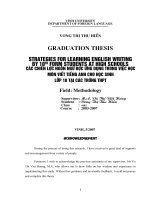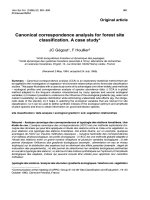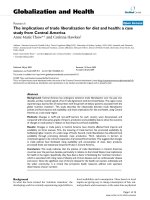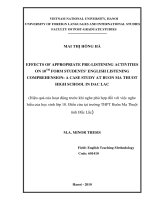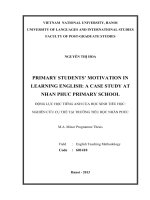Strategies for learning english vocabulary a case study at HOU
Bạn đang xem bản rút gọn của tài liệu. Xem và tải ngay bản đầy đủ của tài liệu tại đây (825.87 KB, 55 trang )
HANOI OPEN UNIVERSITY
FACULTY OF ENGLISH
GRADUATION THESIS
B.A DEGREE IN ENGLISH STUDY
STRATEGIES FOR LEARNING ENGLISH VOCABULARY –
A CASE STUDY AT HOU
Supervisor
: Assoc. Prof. Dr. Hoang Tuyet Minh
Name of student : Nguyen Phuong Hong
Date of birth
: 12/02/1993
Class
: 1271A04 (2012-2016)
Hanoi - 2016
Graduation Paper
DECLARATION
TITLE: STRATEGIES FOR LEARNING ENGLISH VOCABULARY –
A CASE STUDY AT HOU
(Graduation Paper submitted in Partial Fulfillment for B.A Degree in English)
I certify that no part of the above report has been copied and reproduced me
from any other person’s work without acknowledgement and that the report is
originally written by me under strict and enthusiastic guidance of my
supervisor.
Hanoi, 15th April 2016
Student
Supervisor
Nguyen Phuong Hong
Hoang Tuyet Minh
Nguyen Phuong Hong-1271A04-(2012- 2016)
Graduation Paper
ACKNOWLEDGEMENTS
I wish to convey my sincere appreciation to many people who
wholeheartedly helped me to accomplish this paper. Without their guidance
and advice, this paper might not have been completed.
Firstly, I would like to express my deepest gratitude to my supervisor
Assoc. Prof. Dr. Hoang Tuyet Minh for her enthusiatic guidance, thoughtful
and constructive comments on almost every aspect on this study. Without
invaluable supervision and words of encouragement, my study would not
have been completed.
Secondly, I would like to express my special thanks to all the teachers
at English Faculty of HOU for their precious lectures and instructions which
have helped me much in completing the final task.
Thirdly, I also wish to send my thanks to HOU 2nd year English major
students for their animated cooperation in completing my survey
questionnaires.
Finally, I would like to give my great thanks to my beloved friends and
family members who supported me throughout my research paper.
Hopefully, this paper will be useful for learners of English in generals
and the 2nd year English major students at Hanoi Open University.
Hanoi, 15th April, 2016
Student
Nguyen Phuong Hong
Nguyen Phuong Hong-1271A04-(2012- 2016)
Graduation Paper
LIST OF ABBREVIATIONS
COG
cognitive strategies
DET
determination strategies
FOE
Faculty of English
HOU
Hanoi Open University
L1
the first language/ mother tongue
L2
the second language/ foreign language
LLSs
language learning strategies
MEM
memory strategies
MET
metacognitive strategies
SOC
social strategies
STM
short-term memory
LTM
long-term memory
VLS
vocabulary learning strategy
VLSs
vocabulary learning strategies
Nguyen Phuong Hong-1271A04-(2012- 2016)
Graduation Paper
TABLE OF CONTENTS
CHAPTER 1: INTRODUCTION .................................................................. 1
1. Rationale ................................................................................................ 1
2. Aims and objectives of the study .......................................................... 2
3. Scope of the study .................................................................................. 2
4. Research questions ................................................................................ 3
5. Methods of the study ............................................................................. 3
6. Design of the study ................................................................................ 3
CHAPTER 2: LITERATURE REVIEW ....................................................... 5
2.1. Previous studies ................................................................................... 5
2.2. Theoretical background....................................................................... 6
2.2.1. Knowing a word ............................................................................. 6
2.2.2. Vocabulary learning ....................................................................... 8
2.3 Theoretical framework ......................................................................... 9
2.3.1. Definitions of vocabulary learning strategies .................................. 9
2.3.2. Classifications of vocabulary learning strategies .......................... 11
2.3.3. Importance of vocabulary learning strategies ................................ 20
2.3.4. Memory-based strategic framework for vocabulary learning
strategies ................................................................................................ 21
2.4. Summary............................................................................................ 23
CHAPTER 3: THE STUDY ....................................................................... 24
3.1. Methodology ...................................................................................... 24
3.1.1. Survey .......................................................................................... 24
Nguyen Phuong Hong-1271A04-(2012- 2016)
Graduation Paper
3.1.1.1. Questionnaire ......................................................................... 24
3.1.1.2. The subjects............................................................................ 25
3.1.2. Procedure ..................................................................................... 25
3.2. Results ............................................................................................... 26
3.3. Conclusion ......................................................................................... 29
CHAPTER 4: FINDINGS AND DISCUSSION ......................................... 31
4.1. Data Analysis ..................................................................................... 31
4.2. Some suggestions in learning vocabulary ........................................... 31
4.3. Summary ............................................................................................ 39
CHAPTER 5: CONCLUSION .................................................................... 40
REFERENCES ........................................................................................... 41
APPENDIX
Nguyen Phuong Hong-1271A04-(2012- 2016)
Graduation Paper
LIST OF FIGURES AND TABLES
Table 1: What Is Involved in Knowing a Word (Nation, 2001: 27) .............. 7
Table 2: Oxford's Strategy Classification System (Oxford and Ehrman,
1990:313-314).............................................................................................. 17
Table 3 : A taxonomy of vocabulary learning strategies ............................. 18
Table 4: Subjects in use ............................................................................... 25
Table 5: The number of strategies that HOU sophomore uses in learning
vocabulary ................................................................................................... 28
Table 6: The number of students use/ do not use process for vocabulary
learning strategies ....................................................................................... 29
Table 7: Step 1- Sensory memory and vocabulary learning strategies........ 32
Table 8: Step 2- Short-term memory and vocabulary learning strategies ... 37
Table 9: Step 3- Long-term memory and vocabulary learning strategies ... 37
Nguyen Phuong Hong-1271A04-(2012- 2016)
CHAPTER 1: INTRODUCTION
1. Rationale
A language is a systematic means of communication that we all use to
express ourselves and communicate to others. A language is the written and
spoken methods of combining words to create meaning used by a particular
group of people. Over the years, English has become the international
language. This seems to be an appropriate edge to argue that English, in
international settings, plays an increasingly important role. Since English is
regarded as the universal language, lexical competence is seen as the heart of
language learning and the ultimate goal to improve the language competence
of learners. Additionally, vocabulary has been recognized as an important
factor for language learning because inadequate vocabulary knowledge leads
the learners encounter difficulties in language learning.
Learners can significantly improve their language competence by
developing their ability to use vocabulary learning strategies. What is more?
Mastering vocabulary is one of the most challenging tasks that any learner
faces while acquiring another language . Thus, language learning students
need to be trained with the strategies which can help the learners attaining the
meaning of words. The particular strategies which are used by learners for the
acquisition of new words in the second language are called vocabulary
learning strategies. To deal with vocabulary learning problems, vocabulary
learning strategies should have been brought to the language classroom to
boost the learners’ effectiveness in language learning.
In Faculty of English of Hanoi Open University, although strategies for
learning vocabulary is not considered as a major subject, a few researches on
vocabulary learning strategies have been completed by the students of the
Nguyen Phuong Hong-1271A04- (2012- 2016)
1
University. Wherein, the recent study indicates that due to studies for the own
students of HOU, the researchers concluded that it should have some specific
strategies in learning vocabulary, as well as a number of approaches may be
applied for short and long term memory. However, there are still certain
restrictions of these studies such as limitation of setting out a map for
strategies and specific ways to apply them. Therefore, in this study, the
researcher will seek to complement and dig deeper to this interesting topic.
2. Aims and objectives of the study
This study aims at crutinizing the strategies of the second year students
at HOU when using vocabulary learning strategies to learn new words. With
this aim, this study is:
- Identifying vocabulary learning strategy in English. Making a brief
preview of previous studies, classifications and memory-based strategic
framework of vocabulary learning strategies.
- Investigate to find out what kind of strategies most frequently used and
rarely used in the vocabulary acquisition of the second year students.
Indicating the shortcomings in vocabulary learning process of students
to suggest an effective vocabulary learning process.
- Giving some suggestions for vocabulary learning strategies to help
learners acquire vocabulary efficiently.
3. Scope of the study
This study was conducted to examine 46 sophomore students who were
studying at English Faculty of Hanoi Open University. The study mainly
focuses on finding out the most used and the least used strategies, which
frequently employed by students. In addition, the study also gives an
emphasis on the deficiency in vocabulary learning process of learners.
Nguyen Phuong Hong-1271A04- (2012- 2016)
2
4. Research questions
With the aim of this study is locating the shortcomings in vocabulary
learning process to help students to overcome, there are 3 questions need to be
answered:
-
What is the most and the least vocabulary learning strategies used by
students?
-
What is the vocabulary learning process of students at English Faculty
of Hanoi Open University?
-
What is the best vocabulary learning process for students?
5. Methods of the study
The study is conducted by several methods as qualitative, quantitative,
descriptive and analysis. Qualitative is used to collect related information
from previous researches. Quantitative is used to collect data from
questionnaires and students’ answers. Descriptive is used to describe
theoretical background and the figure and answers from questionnaire result.
Analysis is used to analyses data from the result of survey and investigating
problems form the gathered data.
6. Design of the study
For achieving the aims stated, this study is divided into 5 chapters,
references and appendix.
Chapter 1 is entitled Introduction, giving the background and aim of
the study.
Nguyen Phuong Hong-1271A04- (2012- 2016)
3
Chapter 2, Literature review, firstly enumerates some previous studies
about vocabulary learning strategies. Then, theoretical background and
theoretical framework are presented as the foundation for the study.
Chapter 3, The study, submits the survey questionnaire with the help
of the 46 students at HOU and the preliminary results were given.
Chapter 4, Findings and discussion, begins with analyzing the
strategies that HOU students use when learning vocabulary. Next, describes a
common model used by learners when it comes to learn a new word. Finally,
a vocabulary learning process to overcome the shortcoming in vocabulary
acquisition is submitted.
Chapter 5 is the Conclusion, which presents a summary of the study
and suggestions for further research.
REFERENCES
APPENDIX
Nguyen Phuong Hong-1271A04- (2012- 2016)
4
CHAPTER 2: LITERATURE REVIEW
2.1. Previous studies
Through out the years, voluminous studies have done on the subject of
vocabulary acquisiton strategies for learners in expanding their amount of
vocabulary. Concerning direct and indirect strategies, Oxford (1990) brought
out a completed classification of effective learning strategies for vocabulary
learners. From the strategies, which used by the learners alone to strategies,
which required to interact with learners’ peers to achieve the highest
efficiency in learning vocabulary. Seven years later, a large-scale study
conducted by Schmitt (1997) represented sample of 600 students. The
Schmitt’s research is very interesting. First, the comparison of the two set of
data (the most used strategies versus the most useful strategies) revealed some
overlap. There were six strategies in common. Then, patterns of strategy use
change over time as a learner either matures or becomes more proficient in
the target language. Finally, the results indicate that learners willing to try
new strategies if they are introduced and instructed. Since then, Schmitt’s
reasearch was great importance for his proposal of a comprehensive
taxonomy of vocabulary learning strategies. In 1996, Gu and Johnson
administered a questionnaire to 850 second year Chinese University students
to figure out how they use different strategies and how this affects their
learning outcome in terms of vocabulary size and general English proficiency.
The main findings were that: (1) the two metacognitive strategies, selfinitiation and selective attention, tend to be positive and the best predictor of
English proficiency; (2) contextual guessing, skilful use of dictionaries,
contextual encoding, and activation strategies are correlated with both English
proficiency and vocabulary size.
Nguyen Phuong Hong-1271A04- (2012- 2016)
5
Vocabulary Learning Strategy is an interesting topic, which attracted
many researchers study on this topic. These well-known researches
contributed significantly to the field of VLSs and for students who study
English as their second language. What is more? Three research papers are
shared the same ideas. As a result, it supplements the others.
2.2. Theoretical background
2.2.1. Knowing a word
Without a huge amount of words, English learners cannot not only
entirely comprehend the meaning of listening and reading, but also
communicate or express the meaning undoubtedly in the process of speaking
and. However, knowing a word is complicated and there are various
definitions for knowing a word. Nation (2001) applies the terms ‘receptive’
and ‘productive’ to vocabulary knowledge description covering all the aspects
of what is involved in knowing a word as in the following table.
Form
Spoken
Written
Word parts
Meaning Form &
Receptive
What does the word sound like?
Productive
How is the word pronounced?
Receptive
What does the word look like?
Productive
How is the word written and
spelled?
Receptive
What parts are recognizable in this
word?
Productive
What word parts are needed to
express this meaning?
Receptive
What meaning does this word form
Nguyen Phuong Hong-1271A04- (2012- 2016)
6
meaning
signal?
Productive
What word form can be used to
express this meaning?
Concept &
Receptive
What is included in the concept?
referents
Productive
What items can the concept refer
to?
Associations Receptive
Productive
Use
Grammatical Receptive
functions
Collocations
What other words does this make
us think of?
What other words can we use
instead of this one?
In what patterns does this word
occur?
Productive
In what patterns must we use this
word?
Receptive
What words or types of words
occur with this one?
Productive
What words or types of words must
we use with this one?
Constraints
Receptive
on use
(register,
frequency…
Where, when and how often would
we expect to meet this word?
Productive
Where, when and how often can we
use this word?
Table 1: What Is Involved in Knowing a Word (Nation, 2001: 27)
Nguyen Phuong Hong-1271A04- (2012- 2016)
7
However, Mondria and Wiersma (2004) state that productive and receptive
knowledge of a word tend to overlap since certain productive learning leads to
certain amount of productive knowledge. They also point out that productive
learning is more difficult than receptive learning and it takes more time.
Moreover, productive knowledge decays faster than receptive knowledge of a
word.
According to Richards (1976), knowing a lexical item includes
knowledge of word frequency, collocation, register, case relations, underlying
forms, word association, and semantic structure. Ling (2005) states that words
are interwoven in a complex system in which knowledge of various levels of
a lexical item is required in order to achieve adequate understanding in
listening and reading or produce ideas successfully in speaking and writing.
In this section, we have been acquainted with the concepts of knowing
a word through the concepts of receptive and productive of the Nation. The
conceptual knowledge of word frequency, collocation, register, case relations,
underlying forms, word association, and semantic structure of Richards or the
level of word understanding based on the ability to apply it in four skill such
as reading, writing, listening and speaking. From here, the concept of a lexical
item is putted in for further studies of the strategies’ definitions.
2.2.2. Vocabulary learning
Learning vocabulary is an arduous task. The task of vocabulary
learning is to see the distinction between knowing a word and using it.
Learning vocabulary should focus on remembering words and using them
easily in the right contexts. Evidence suggests that the knowledge aspect
requires employment of conscious mechanisms of learning while the skill
Nguyen Phuong Hong-1271A04- (2012- 2016)
8
aspect involves implicit learning (Ellis, 1994). This is essential in selecting
strategies for both using words as well as knowing them.
Nation (1990:33-50) remarks three factors which have influence on
making a word difficult to learn. The first is the learners’ previous
experiences of English and their mother tongue since one’s first language
affects the second language vocabulary acquisition and usually borrowing and
interference between first and second language vocabulary occurs. The
second factor is the way a word is learned or taught. The third aspect is the
intrinsic difficulty of the word which basically means that some words are
harder than others.
Laufer (1997:154) also mentioned the several factors which can make
learning a word difficult. For example, phonological factors, length, semantic
features, abstractness and multiple meaning may have an impact on how
easily the word can be learned.
In terms of learning vocabulary definitions, while (Ellis, 1994) refers to
the concept of “Conscious mechanisms of learning”, the Nation (1990) and
Laufer (1997) point out the factors that make us realize that learning English
vocabulary is not an easy task. From these points, a question is brought out to
see whether there are strategies that can help learners to accumulate
vocabulary more efficient and easier?
2.3 Theoretical framework
2.3.1. Definitions of vocabulary learning strategies
Throughout numerous studies, the definitions of “Languague learning
strategies (LLSs)” were dissected by the scholars all around the world to
contribute to a comprehensive definition of LLS.
Nguyen Phuong Hong-1271A04- (2012- 2016)
9
O’Malley and Chamot (1990, p. 1) define language learning strategies
as “the special thoughts or behaviours that individuals use to help them
comprehend, learn, or retain new information.” Oxford (1990, p. 8) states that
language learning strategies are “specific actions taken by the learner to make
learning easier, faster, more enjoyable, more self-directed, and more
transferable to new situations.” Nunan (1991, p. 168) sees language learning
strategies as “the mental processes which learners employed to learn and use
the target language.”
Though VLLs is a branch of LLSs, there are few definitions are given
for VLSs. The working definition of vocabulary learning strategies in this
research is adapted from Rubin. Rubin (1987, p. 29) defines lexical strategies
as “the process by which information is obtained, stored, retrieved, and used”
and “therefore vocabulary learning strategies could be any which affect this
broadly-defined process”. Follow this statement closely, Ellis (1999) defines
VLSs are “Specific strategies for learning vocabulary”.
But it seems that these definitions are still vague for the students and
researchers in the field of VLSs. So that, Nation (2001) sorted out that there
are 3 categories of strategies: planning, sources, and processes, each covering
a subset of strategies. ‘Planning’ involves choosing what and when to focus
attention on the vocabulary items. This category contains strategies for
choosing words, choosing the aspects of word knowledge, choosing
strategies, and planning repetition. ‘Sources’ refers to finding information
about words from analyzing the words; context, dictionary. ‘Process’ means
establishing lexical knowledge through powerful processes as noticing,
retrieving and generating. Two years later, Further, Catalán (2003, p. 56) sees
VLSs as “knowledge about the mechanisms (process, strategies) used in order
Nguyen Phuong Hong-1271A04- (2012- 2016)
10
to learn vocabulary as well as steps or actions taken by students (a) to find out
the meaning of unknown words, (b) to retain them in long-term memory, (c)
to recall them at will, and (d) to use them in oral or written mode.”
Eventually, in the year of 2011, Asgari and Mustapha gave a definition is
considered to be compendious, concise and newest definition of VLSs. Asgari
and Mustapha (2011, p.85) defined VLSs as ‘steps taken by the language
learners to acquire new English words.”
Therefore, it can be said that VLSs are commonly used not only to
discover the meanings of unknown words but also to retain them in long-term
memory and to recall them at will.
In short, in this part, definitions of VLSs were extracted based on the
definitions of LLSs and a few brief definitions of some of the recent research.
These definitions will provide the foundation for the classifications of the
VLS types, and help the researcher to take a futher step in finding out the
effective strategies for vocabulary acquisition.
2.3.2. Classifications of vocabulary learning strategies
In the world, there are many large and small researches on vocabulary
learning strategie. All these strategies spread over various aspects of
vocabulary, such as strategies of grammar, semantic meanings, forms, prefix
and suffix strategies,…there are also strategies related to human memory
process or psychology. Within the limitation of this study, three famous
studies about VLSs are brought out to be the framework for the study. Firstly,
study of Oxford (1990) refers to VLSs in a fairly comprehensive way,
followed by the study based on the Oxford platform of scholar Schmitt
(1997). One of the things that made his research famous is that he has added
to the Oxford research: strategies of encountering a new word. In 1996, Gu
Nguyen Phuong Hong-1271A04- (2012- 2016)
11
and Johnson also were well known for not only having the same ideas about
the vocabulary learning strategies two studies but also the outstanding
strategies related to human memory processes. Overall, these three studies
added to the others to contribute to VLSs of learners.
Oxford
(1990)
proposed
“perhaps
the
most
comprehensive
classification of language learning strategies to date” (Ellis, 1994:539).
Oxford’ taxonomy of language learning strategies is direct strategies and
indirect strategies.
Direct strategies involve directly and deal with the target language
Memory strategies Techniques specially adapted to help learners to store new
information and restore it later, such as, grouping, associating or elaborating,
placing new words into a context, using imagery, semantic mapping,
keywords, representing sounds in memory, reviewing structurely, using
physical response or sensation, or using mechanical techniques
. And
cognitive strategies skills involve manipulation or transformation of the
language material in direct ways, for example, repeating, practicing with
sounds, recognizing and using formulas and patterns, recombining, practising
naturalistically. Compensation strategies Behaviors used to compensate for
missing knowledge of some kind like: guessing meaning from context and
using synonyms and gestures to convey meaning.
Indirect
strategies
support
and
manage
language
learning
Metacognitive Strategies Behaviors used for centering, arranging, planning,
and evaluating ones’ learning social strategies actions involving other people
in the language learning process like: questioning and cooperating with peers.
Affective strategies techniques which help learners to gain better control over
Nguyen Phuong Hong-1271A04- (2012- 2016)
12
their emotions, motivation, and attitudes related to language learning, for
example, reducing anxiety, self-encouragement and self-reward.
Direct Strategies : Memory, Cognitive, and Compensation Strategies
Memory
Creating
strategies
Linkages
Mental Grouping
Associating/elaborating
Placing new words into a
context
Applying images and Using imagery
sounds
Semantic mapping
Using keywords
Representing
sounds
in
memory
Reviewing well
Structured reviewing
Employing action
Using physical response or
sensation
Using mechanical techniques
Cognitive
Practicing
strategies
Repeating
Formally
practicing
with
sounds and writing systems
Recognizing
Nguyen Phuong Hong-1271A04- (2012- 2016)
and
using
13
formulas and patterns
Recombining
Practicing naturalistically
Receiving and sending Getting the idea quickly
messages
Using resources for receiving
and sending messages
Analyzing
and Reasoning deductively
reasoning
Analyzing expressions
Analyzing
contrastively
(across languages)
Translating
Transferring
Creating structure for Taking notes
input & output
Summarizing
Highlighting
Comprehension
Guessing intelligently
strategies
Using linguistic clues
Using other clues
Overcoming limitations Switching
to
the
mother
in speaking and writing tongue
Nguyen Phuong Hong-1271A04- (2012- 2016)
14
Getting help
Using mime or gesture
Avoiding
communication
partially or totally
Selecting the topic
Adjusting or approximating
the message
Coining words
Using a circumlocution or
synonym
Indirect Strategies: Metacognitive, Affective, and Social Strategies
Metocognitive
Centering
Strategies
listening
your Overviewing
and
linking
with
already known material
Paying attention
Delaying
speech
production
to
focus on listening
Arranging
Planning
and Finding out about language learning
your
Organizing
learning
Setting goals and objectives
Identifying
language
Nguyen Phuong Hong-1271A04- (2012- 2016)
the
task
purpose
of
a
(purposeful
15
listening/reading/speaking/writing)
Planning for a language task
Seeking practice opportunities
Evaluating
your Self-monitoring
learning
Affective
Lowering
Strategies
anxiety
Self-evaluating
your Using progressive relaxation, deep
breathing or meditation
Using music
Using laughter
Encouraging
Making positive statements
yourself
Taking risks wisel
Rewarding yourself
Taking
your Listening to your body
emotional
Using a checklist
temperature
Writing a language learning diary
Discussing
your
feelings
with
someone else
Social
Strategies
Asking questions
Asking
for
clarification
or
verification
Nguyen Phuong Hong-1271A04- (2012- 2016)
16
Asking for correction
Cooperating
others
with Cooperating with others
Cooperating with proficient users of
the new language
Empathizing
others
with Developing cultural understanding
Becoming aware of others' thoughts
and feelings
Table 2: Oxford's Strategy Classification System (Oxford and Ehrman,
1990:313-314)
Although, Oxford’s strategy classification is well known for it’s
plentiful of VLSs, which classified into four strategy groups: Social, Memory,
Cognitive, and Metacognitive. Social Strategies (SOC) is employed to
interaction with other people to improve language learning. Approaches draw
on new material to existing knowledge fall into the Memory Strategies
(MEM) category. Cognitive Strategies (COG) exhibit the common function
of "manipulation or transformation of the target language by the learner"
(Oxford, 1990:43). Initally, Metacognitive Strategies (MET) involve a
conscious overview of the learning process and making decisions about
planning, monitoring, or evaluating the best ways to study. However, Schmitt
(1997) states that “Oxford's classification system was unsatisfactory in
categorizing vocabulary-specific strategies in several respects”. He pointed
out there are 3 inadequate categorization in Oxfords’ classifications. First,
there is no category in Oxford's taxonomy which adequately describes the
kind of strategies used by an individual when faced with discovering a new
word's meaning without recourse to another person's expertise.
Nguyen Phuong Hong-1271A04- (2012- 2016)
It was
17
therefore necessary to create a new category for these strategies:
Determination Strategies (DET). Furthermore, Oxford's categories proved
inadequate in places, as some strategies could easily fit into two or more
groups, making their classification difficult. For example, interacting with
native speakers is obviously a Social Strategy, but if it is part of an overall
language learning plan, it could also be a Metacognitive Strategy. He asserted
that “it is often unclear whether some strategies should be classified as
Memory Strategies or Cognitive Strategies”. Thirdly, when it comes to facing
a new vocabulary item, learners must use their knowledge to discover the
contextual clues, or reference materials to find out the meaning
(Determination Strategies), or learners also can ask people who know the
meaning (Social Strategies). These strategies for gaining initial information
about a new word are labeled Discovery Strategies.
From all these above realization and commentation, Schmitt (1977)
falls into two main groups of strategies: discovery strategies and consolidation
strategies of his taxonomy and this classification gives a vital contribution to
the lexical knowledge.This following table illustrates the complete
classification scheme proposed by Schmitt.
Vocabulary
Discovery strategies
Learning Strategies
(VLS)
Consolidation
strategies
Determination strategies
Social strategies
Social strategies
Memory strategies
Cognitive strategies
Metacognitve strategies
Table 3 : A taxonomy of vocabulary learning strategies
Nguyen Phuong Hong-1271A04- (2012- 2016)
18
